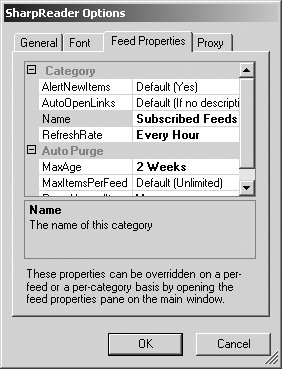Avoid Overwhelming Servers
| Another thing to consider when you start a new RSS feed is the number of possible readers. Having thousands of people checking your Web site hourly for updates could be a problem if your Web server limits your bandwidth or, worse, charges you for bandwidth over a certain amount per day. You might end up with substantial costs, or some readers might not be able to get your feed. On the other hand, RSS is XML, which means it's text. That's good because text is relatively small, so it won't take too much bandwidth to send. Still, there are a number of things you can do to avoid taking too much bandwidth to support your feed:
If you're working with readers you know, you can ask them to change the frequency with which their RSS reader programs check for updates. For example, SharpReader lets you set the time between updates in the Options dialog (Figure 10.3). Figure 10.3. SharpReader lets you set the time interval between checking a feed for updates. |
